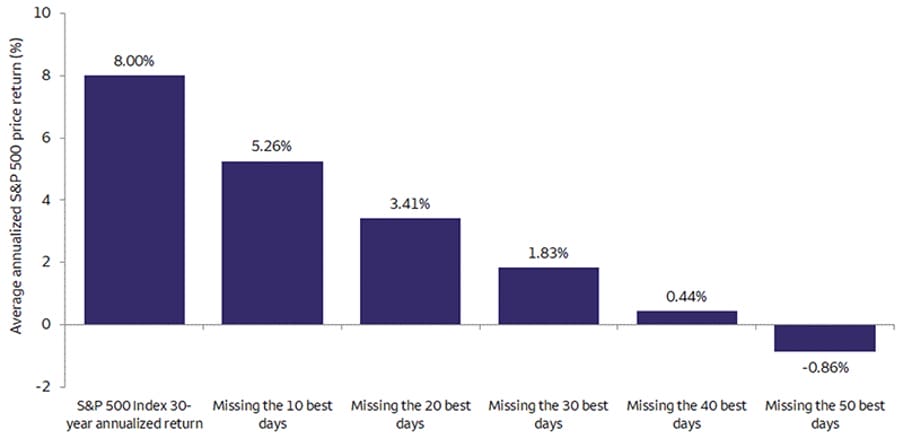Links between the ‘beautiful game’ and investing aren’t always obvious. With the new football season now well underway, Sheldon MacDonald, CIO of Marlborough, draws some interesting parallels as he concludes that when it comes to investing, being prepared to stand your ground is an often-underrated skill.
According to a study of almost a thousand spot-kicks in Germany’s Bundesliga, the best thing a goalkeeper can do when facing a penalty is stand still. Forget diving right or left in the hope of pulling off a spectacular fingertip save. Just stay put.
Researchers found around 15% of penalties are hit straight down the middle. A keeper who doesn’t budge has a near-100% chance of blocking the ball in such instances.
By contrast, the likelihood of success for those who heroically fling themselves one way or another is low. This is the case even if they correctly guess which way a taker will shoot[1].
So why do keepers so rarely hold their ground? The psychological explanation lies in “action bias” – a term used to describe humans’ innate tendency to favour doing something over doing nothing.
Sometimes we prefer action over inaction because we’re sure it will be to our benefit. Yet there are also occasions when we feel compelled to act despite there being no evidence that doing so will bring a superior outcome. We might even act simply because we believe we should be seen to be doing something.
Such thoughts are likely uppermost in many investors’ minds after volatility returned to the markets with a vengeance. Yet in this sphere, too, experience suggests the optimum approach could be to stand firm.
The cost of missing out
The so-called “Magnificent Seven” US technology stocks underpinned global equity performance throughout 2023 and during the first half of 2024. Alphabet, Amazon, Apple, Meta, Microsoft, Nvidia and Tesla were responsible for around 60% of the S&P 500’s total return last year[2], and by the end of this June they made up 31% of the index.
Lately, however, investor faith in these companies has been rocked. They shed a combined market value of $2.6 trillion over the 20 days leading up to August 1, with Nvidia – the Yul Brynner of the bunch – plunging by 23% and kissing goodbye to $800 billion.
The perils of trying to time the markets
Does this mean investors should get out of US stocks with all speed? Might they even turn their backs on equities as a whole, seek refuge elsewhere and so live to fight another day?
Such measures might sound sensible amid the ongoing tumult, and it’s true that they could help investors escape additional damage from further falls. Yet attempting to time markets in this way carries its own risks.
The perils of taking action for the sake of it are easy to demonstrate. The S&P 500 has delivered an average annualised return of 8% over the past 30 years, as figure 1 shows, but missing the market’s 10 best days during that period would have dropped the figure to just over 5%.
Even more strikingly, an investor who missed the 40 best days would have barely broken even – while missing the 50 best days would have produced a negative return[3]. The lesson: more money can be lost in trying to avoid the next market pullback than in the pullback itself.
Figure 1: The perils of trying to time the market

Source: Bloomberg, Wells Fargo Investment Institute, as at January 31 2024; for illustrative purposes only; past performance is not a guide to future returns
Grounds for maintaining a long-term view
There are a number of reasons why markets are jittery at present. Most centre on the US. They include renewed fears of recession, concerns that the Federal Reserve is “behind the curve” in cutting rates, disappointing Big Tech earnings reports and fresh uncertainty over the result of the presidential election.
Add the prospect of an escalation in the conflict in the Middle East and you have a pretty challenging landscape. Accordingly, no-one can say with confidence when the current bout of volatility might fade away.
Yet most of the drivers of the recent equity rally are still in place. Rates are coming down, even if not quite as quickly as envisaged. Many companies are generating solid earnings. Beyond the Magnificent Seven, valuations are attractive. There are plenty of opportunities to be found. Taking a long-term view lets you see the attractions beyond the immediate turmoil.
Although equities have fallen, fixed income assets have performed well. This highlights why it can be prudent to build diversified portfolios across asset classes, regions, sectors, market capitalisations and investment styles while always remaining focused on their own time horizons, goals, risk attitudes and ability to endure difficult spells.
Realistically, standing still isn’t the greatest advice for saving penalties – at least over time. Any keeper who earns a reputation as a goal-line statue should soon find opponents slotting home with embarrassing regularity. Team-mates, coaches and fans may be less than amused as one shot after another is calmly dispatched to the left or right.
In the investment world, though, the lasting appeal of holding firm in the face of pressure is altogether clearer. All things considered, it’s investors who succumb to action bias, make knee-jerk decisions and frantically leap this way or that who are more likely to end up disconsolately picking the ball out of the net.
Sheldon MacDonald is CIO of Marlborough.
[1] See, for example, Inner Drive: “The sport psychology of perfect penalties” – https://www.innerdrive.co.uk/blog/psychology-perfect-penalties/#:~:text=After%20penalties&text=Their%20analysis%20showed%20that%20when,of%20the%20next%20penalty%20taker.
[2] See, for example, Forbes: “2023 in review: stock market resilience and the rise of the Magnificent Seven”, December 26 2023 – https://www.forbes.com/sites/greatspeculations/2023/12/26/2023-in-review-stock-market-resilience-and-the-rise-of-the-magnificent-seven/.
[3] See, for example, Wells Fargo Investment Institute: “The perils of trying to time volatile markets”, February 29 2024 – https://saf.wellsfargoadvisors.com/emx/dctm/Research/wfii/wfii_reports/Investment_Strategy/perils_trying_time_volatile_markets.pdf.















